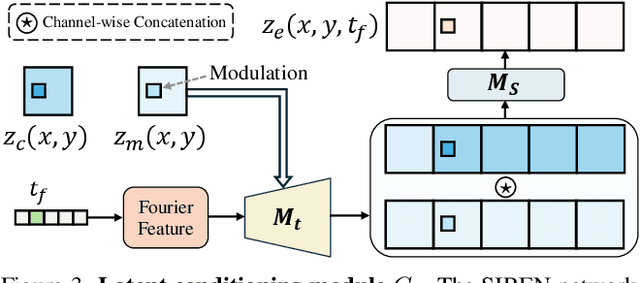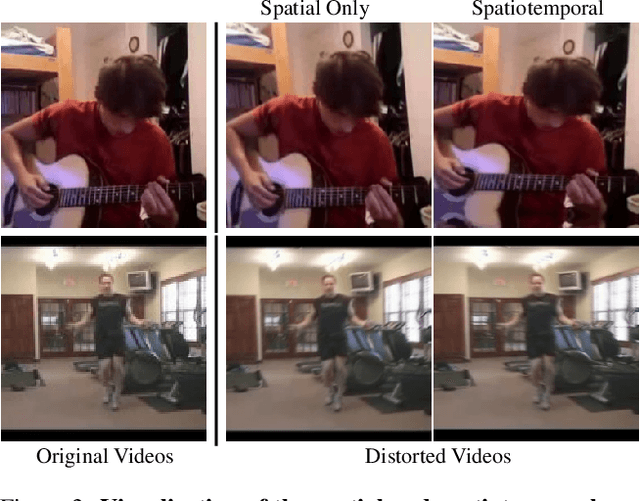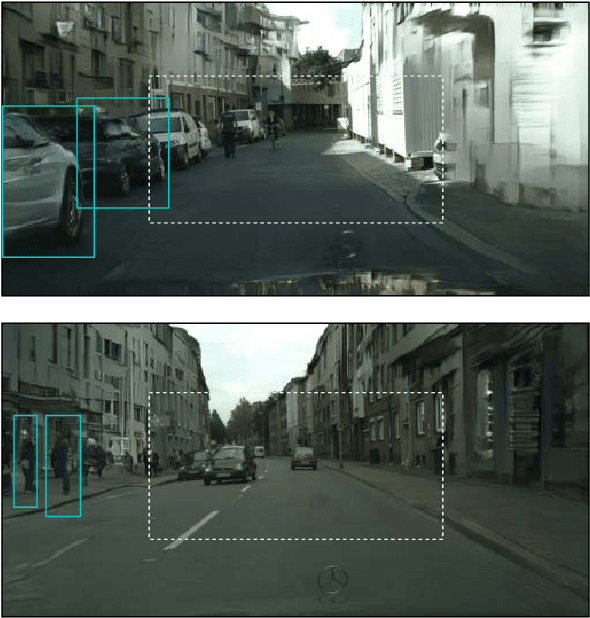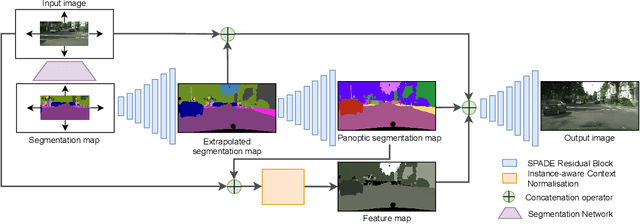Aniruddha Mahapatra
REGEN: Learning Compact Video Embedding with (Re-)Generative Decoder
Mar 11, 2025



Abstract:We present a novel perspective on learning video embedders for generative modeling: rather than requiring an exact reproduction of an input video, an effective embedder should focus on synthesizing visually plausible reconstructions. This relaxed criterion enables substantial improvements in compression ratios without compromising the quality of downstream generative models. Specifically, we propose replacing the conventional encoder-decoder video embedder with an encoder-generator framework that employs a diffusion transformer (DiT) to synthesize missing details from a compact latent space. Therein, we develop a dedicated latent conditioning module to condition the DiT decoder on the encoded video latent embedding. Our experiments demonstrate that our approach enables superior encoding-decoding performance compared to state-of-the-art methods, particularly as the compression ratio increases. To demonstrate the efficacy of our approach, we report results from our video embedders achieving a temporal compression ratio of up to 32x (8x higher than leading video embedders) and validate the robustness of this ultra-compact latent space for text-to-video generation, providing a significant efficiency boost in latent diffusion model training and inference.
MotionCanvas: Cinematic Shot Design with Controllable Image-to-Video Generation
Feb 06, 2025



Abstract:This paper presents a method that allows users to design cinematic video shots in the context of image-to-video generation. Shot design, a critical aspect of filmmaking, involves meticulously planning both camera movements and object motions in a scene. However, enabling intuitive shot design in modern image-to-video generation systems presents two main challenges: first, effectively capturing user intentions on the motion design, where both camera movements and scene-space object motions must be specified jointly; and second, representing motion information that can be effectively utilized by a video diffusion model to synthesize the image animations. To address these challenges, we introduce MotionCanvas, a method that integrates user-driven controls into image-to-video (I2V) generation models, allowing users to control both object and camera motions in a scene-aware manner. By connecting insights from classical computer graphics and contemporary video generation techniques, we demonstrate the ability to achieve 3D-aware motion control in I2V synthesis without requiring costly 3D-related training data. MotionCanvas enables users to intuitively depict scene-space motion intentions, and translates them into spatiotemporal motion-conditioning signals for video diffusion models. We demonstrate the effectiveness of our method on a wide range of real-world image content and shot-design scenarios, highlighting its potential to enhance the creative workflows in digital content creation and adapt to various image and video editing applications.
Progressive Growing of Video Tokenizers for Highly Compressed Latent Spaces
Jan 09, 2025Abstract:Video tokenizers are essential for latent video diffusion models, converting raw video data into spatiotemporally compressed latent spaces for efficient training. However, extending state-of-the-art video tokenizers to achieve a temporal compression ratio beyond 4x without increasing channel capacity poses significant challenges. In this work, we propose an alternative approach to enhance temporal compression. We find that the reconstruction quality of temporally subsampled videos from a low-compression encoder surpasses that of high-compression encoders applied to original videos. This indicates that high-compression models can leverage representations from lower-compression models. Building on this insight, we develop a bootstrapped high-temporal-compression model that progressively trains high-compression blocks atop well-trained lower-compression models. Our method includes a cross-level feature-mixing module to retain information from the pretrained low-compression model and guide higher-compression blocks to capture the remaining details from the full video sequence. Evaluation of video benchmarks shows that our method significantly improves reconstruction quality while increasing temporal compression compared to direct extensions of existing video tokenizers. Furthermore, the resulting compact latent space effectively trains a video diffusion model for high-quality video generation with a reduced token budget.
On the Content Bias in Fréchet Video Distance
Apr 18, 2024



Abstract:Fr\'echet Video Distance (FVD), a prominent metric for evaluating video generation models, is known to conflict with human perception occasionally. In this paper, we aim to explore the extent of FVD's bias toward per-frame quality over temporal realism and identify its sources. We first quantify the FVD's sensitivity to the temporal axis by decoupling the frame and motion quality and find that the FVD increases only slightly with large temporal corruption. We then analyze the generated videos and show that via careful sampling from a large set of generated videos that do not contain motions, one can drastically decrease FVD without improving the temporal quality. Both studies suggest FVD's bias towards the quality of individual frames. We further observe that the bias can be attributed to the features extracted from a supervised video classifier trained on the content-biased dataset. We show that FVD with features extracted from the recent large-scale self-supervised video models is less biased toward image quality. Finally, we revisit a few real-world examples to validate our hypothesis.
Synthesizing Artistic Cinemagraphs from Text
Jul 12, 2023Abstract:We introduce Text2Cinemagraph, a fully automated method for creating cinemagraphs from text descriptions - an especially challenging task when prompts feature imaginary elements and artistic styles, given the complexity of interpreting the semantics and motions of these images. Existing single-image animation methods fall short on artistic inputs, and recent text-based video methods frequently introduce temporal inconsistencies, struggling to keep certain regions static. To address these challenges, we propose an idea of synthesizing image twins from a single text prompt - a pair of an artistic image and its pixel-aligned corresponding natural-looking twin. While the artistic image depicts the style and appearance detailed in our text prompt, the realistic counterpart greatly simplifies layout and motion analysis. Leveraging existing natural image and video datasets, we can accurately segment the realistic image and predict plausible motion given the semantic information. The predicted motion can then be transferred to the artistic image to create the final cinemagraph. Our method outperforms existing approaches in creating cinemagraphs for natural landscapes as well as artistic and other-worldly scenes, as validated by automated metrics and user studies. Finally, we demonstrate two extensions: animating existing paintings and controlling motion directions using text.
GEMS: Scene Expansion using Generative Models of Graphs
Jul 08, 2022



Abstract:Applications based on image retrieval require editing and associating in intermediate spaces that are representative of the high-level concepts like objects and their relationships rather than dense, pixel-level representations like RGB images or semantic-label maps. We focus on one such representation, scene graphs, and propose a novel scene expansion task where we enrich an input seed graph by adding new nodes (objects) and the corresponding relationships. To this end, we formulate scene graph expansion as a sequential prediction task involving multiple steps of first predicting a new node and then predicting the set of relationships between the newly predicted node and previous nodes in the graph. We propose a sequencing strategy for observed graphs that retains the clustering patterns amongst nodes. In addition, we leverage external knowledge to train our graph generation model, enabling greater generalization of node predictions. Due to the inefficiency of existing maximum mean discrepancy (MMD) based metrics for graph generation problems in evaluating predicted relationships between nodes (objects), we design novel metrics that comprehensively evaluate different aspects of predicted relations. We conduct extensive experiments on Visual Genome and VRD datasets to evaluate the expanded scene graphs using the standard MMD-based metrics and our proposed metrics. We observe that the graphs generated by our method, GEMS, better represent the real distribution of the scene graphs than the baseline methods like GraphRNN.
Controllable Animation of Fluid Elements in Still Images
Dec 06, 2021



Abstract:We propose a method to interactively control the animation of fluid elements in still images to generate cinemagraphs. Specifically, we focus on the animation of fluid elements like water, smoke, fire, which have the properties of repeating textures and continuous fluid motion. Taking inspiration from prior works, we represent the motion of such fluid elements in the image in the form of a constant 2D optical flow map. To this end, we allow the user to provide any number of arrow directions and their associated speeds along with a mask of the regions the user wants to animate. The user-provided input arrow directions, their corresponding speed values, and the mask are then converted into a dense flow map representing a constant optical flow map (FD). We observe that FD, obtained using simple exponential operations can closely approximate the plausible motion of elements in the image. We further refine computed dense optical flow map FD using a generative-adversarial network (GAN) to obtain a more realistic flow map. We devise a novel UNet based architecture to autoregressively generate future frames using the refined optical flow map by forward-warping the input image features at different resolutions. We conduct extensive experiments on a publicly available dataset and show that our method is superior to the baselines in terms of qualitative and quantitative metrics. In addition, we show the qualitative animations of the objects in directions that did not exist in the training set and provide a way to synthesize videos that otherwise would not exist in the real world.
SemIE: Semantically-aware Image Extrapolation
Aug 31, 2021



Abstract:We propose a semantically-aware novel paradigm to perform image extrapolation that enables the addition of new object instances. All previous methods are limited in their capability of extrapolation to merely extending the already existing objects in the image. However, our proposed approach focuses not only on (i) extending the already present objects but also on (ii) adding new objects in the extended region based on the context. To this end, for a given image, we first obtain an object segmentation map using a state-of-the-art semantic segmentation method. The, thus, obtained segmentation map is fed into a network to compute the extrapolated semantic segmentation and the corresponding panoptic segmentation maps. The input image and the obtained segmentation maps are further utilized to generate the final extrapolated image. We conduct experiments on Cityscapes and ADE20K-bedroom datasets and show that our method outperforms all baselines in terms of FID, and similarity in object co-occurrence statistics.
 Add to Chrome
Add to Chrome Add to Firefox
Add to Firefox Add to Edge
Add to Edge